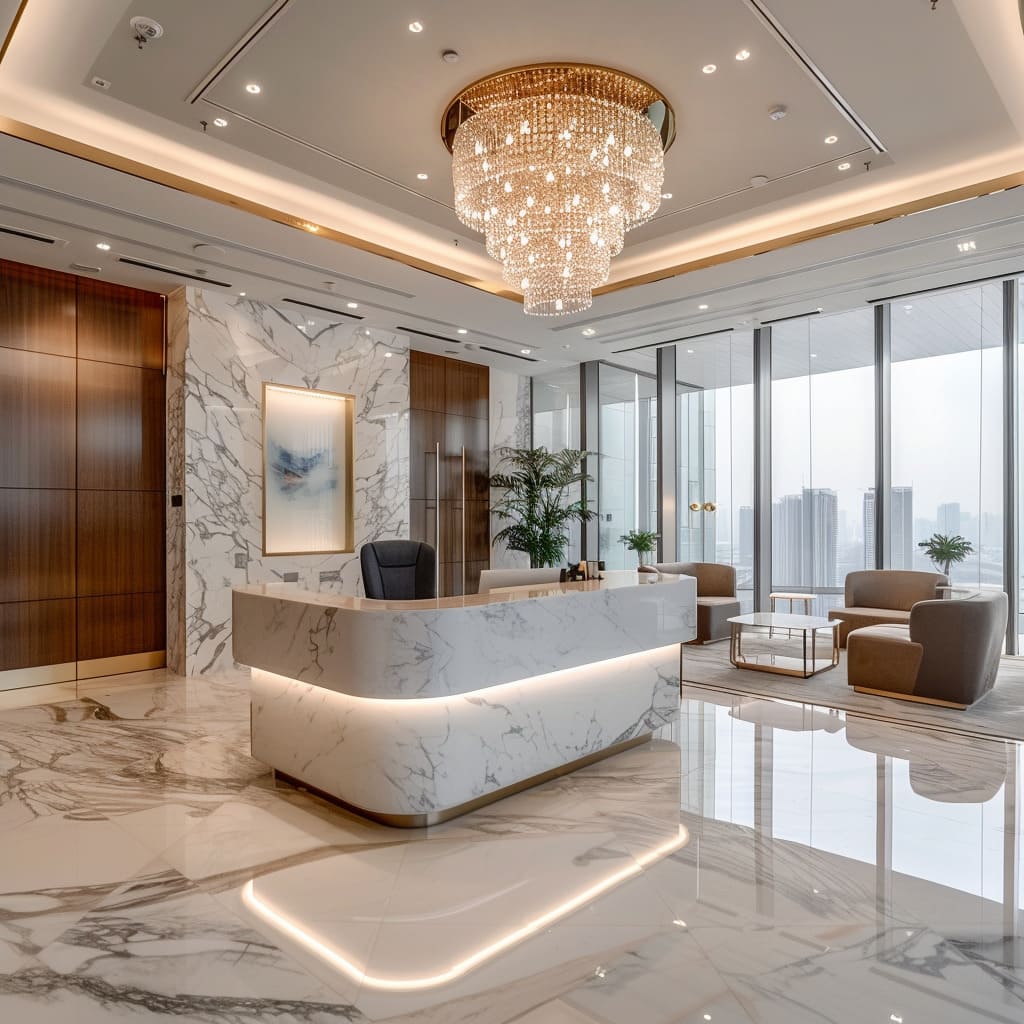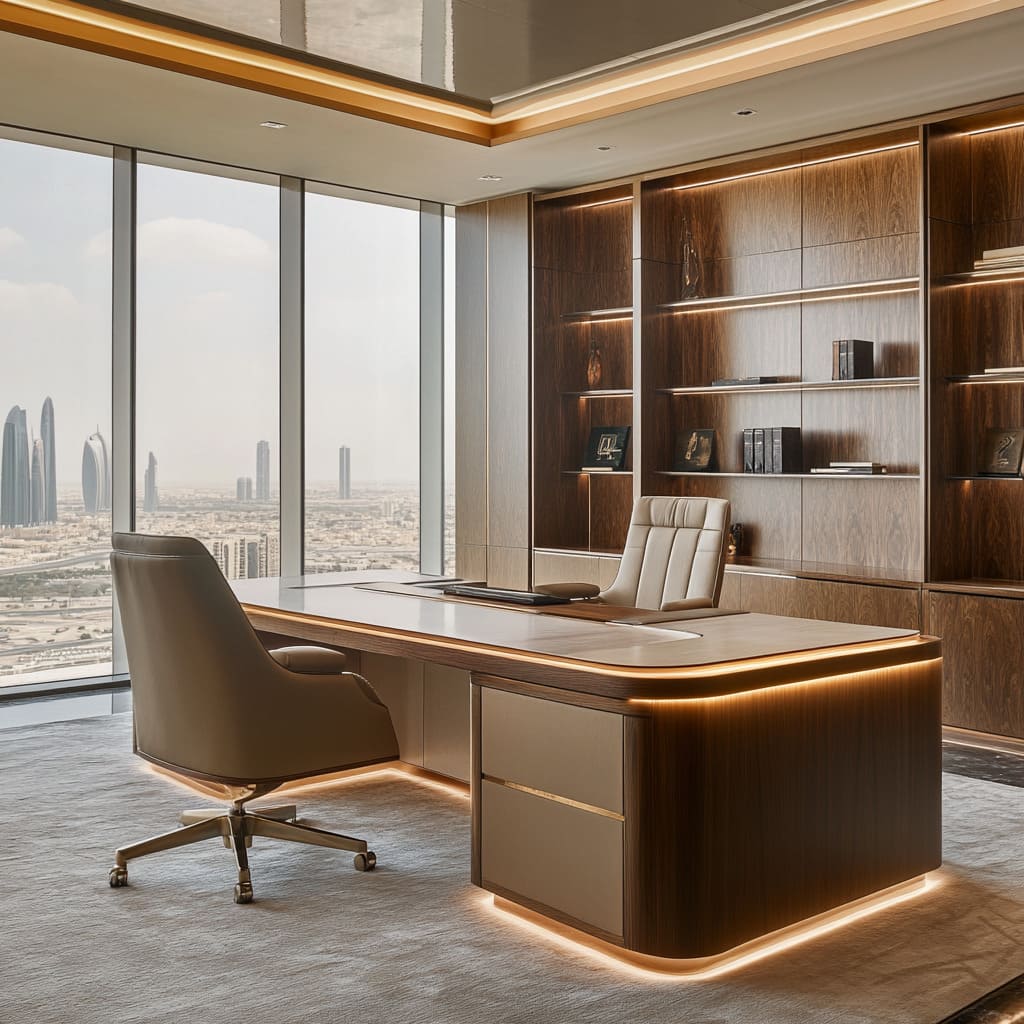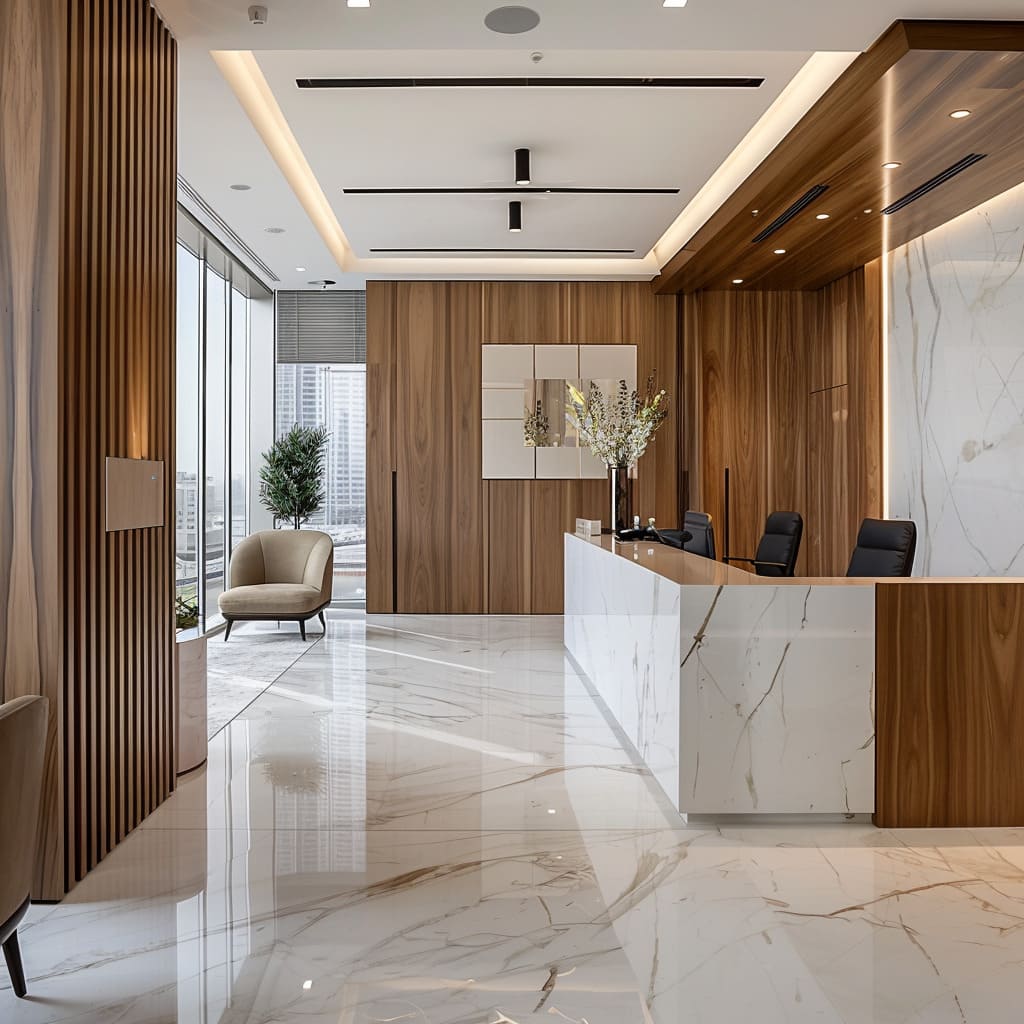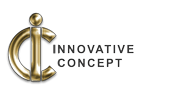In Dubai, the modern office space has evolved, moving beyond the typical sterile environment. The latest trend in the city’s ever-growing design world embraces the essence of minimalism but gives it a refined, luxurious edge. Sleek lines, neutral palettes, and open layouts are paired with high-end materials like marble, brass, and premium fabrics, transforming workspaces into places of understated sophistication. This balance between simplicity and opulence is setting the stage for the future of office interiors, bringing together functionality and design in a unique way that reflects the character of Dubai.

The Minimalist Foundation
Less Is More
Minimalism has always been associated with clarity and focus, and it forms the backbone of this design trend. In Dubai’s offices, this approach emphasizes uncluttered environments, neutral tones, and open layouts. Spaces are structured with intention, where every corner is used thoughtfully. White, beige, soft grey, and muted earth tones dominate the color schemes, creating a backdrop that feels expansive rather than confined.
The design doesn’t merely strip down the space; it makes sure that what’s left behind is purposeful. Large, open areas allow for flexibility and movement, fostering a collaborative work environment while ensuring a comfortable flow. Desks, tables, and seating are streamlined, often geometric in form, contributing to a clean and organized look. Yet, these offices are far from cold or bland. There’s a subtle warmth, a sense of balance created by thoughtful lighting, open sightlines, and a focus on natural materials.
Introducing Luxe Elements
From Marble to Brass
While the minimalist foundation emphasizes simplicity, it is the introduction of luxury materials that sets Dubai’s office spaces apart. Materials like marble and brass aren’t used for grandeur alone but are integrated in ways that enhance both the aesthetics and functionality of the space.
Marble, for example, often finds its way into conference tables, reception desks, or feature walls. Its polished surface not only adds a refined texture but also plays with the light, creating a subtle shimmer that contrasts with the clean lines of minimalist design. Unlike traditional uses of marble in overly ornate settings, here it is employed in a restrained, deliberate manner. It provides a sense of stability and permanence while maintaining the calm atmosphere expected from minimalist environments.
Brass, on the other hand, introduces a touch of warmth. Used sparingly in light fixtures, door handles, or as trim on furniture, it adds a contrast that is not overpowering. Brass detailing is used to highlight the simplicity of the design rather than compete with it, offering a modern, sophisticated touch. The natural sheen of brass gives a subtle glow that complements the neutral color palette, enhancing the overall aesthetic without detracting from the minimalist appeal.

Premium Fabrics for Comfort and Style
Softening Minimalism
Incorporating high-quality fabrics plays a crucial role in adding warmth and comfort to these spaces. While minimalism might traditionally evoke a cooler, more detached look, in Dubai’s offices, that’s far from the case. Upholstered seating in premium materials like leather, velvet, and fine linens helps create inviting and comfortable zones without compromising the minimalist aesthetic.
The fabric choices are intentional, providing a tactile experience that softens the starkness often associated with minimalism. Leather, often used in seating areas, balances durability with style. Its texture adds depth to the otherwise smooth surfaces seen in minimalism, while its organic quality blends seamlessly with the natural materials used elsewhere. Velvet or linen cushions in muted tones are used sparingly to bring a sense of relaxation to lounges or breakout areas. These fabrics, while subtle, introduce a hint of luxury, reinforcing the high-end approach to minimalist design.
Subtle Luxurious Details
Lighting, Furniture, and Beyond
Details play a significant role in elevating a minimalist space to one that feels luxurious. In Dubai’s office interiors, designers carefully select lighting and furniture to serve dual purposes: functional yet visually striking. Rather than grand chandeliers or overly decorative pieces, the focus is on sleek lighting fixtures that add a sculptural element to the room. Hanging lights with thin, brass frames or understated ceiling fixtures with soft diffused light create an ambiance that complements the minimalist design.
Furniture follows a similar philosophy, where simple, elegant forms are paired with materials like natural wood or stone. Desks with marble tops and brass legs, minimalist shelving with sleek finishes, or modular sofas with clean lines emphasize that luxury is as much about restraint as it is about opulence. Every piece feels intentional, designed to enhance the space without overwhelming it.
Beyond furniture and lighting, other small details—such as sculptural vases, polished stone accessories, or even the choice of a subtly patterned rug—add a personal touch to the space. These elements don’t compete for attention but quietly reinforce the balance between luxury and minimalism.
The Dubai Influence
Cultural Context Meets Contemporary Design
What makes Dubai’s minimalist-luxury office design truly unique is the way it integrates elements of local culture. The city’s rich heritage subtly influences these contemporary spaces, ensuring that the design feels both modern and rooted in tradition. Arabic patterns, geometric shapes, and natural textures find their way into these offices, often in understated ways. Whether it’s the delicate latticework in a brass partition or the soft geometric pattern of a rug, these influences are incorporated in a manner that complements the sleek, modern aesthetic.
The beauty of this approach lies in its subtlety. Rather than overwhelming the space with overtly traditional designs, these cultural elements are woven seamlessly into the broader minimalist-luxury scheme. It’s a nod to the city’s identity while ensuring the office remains firmly in the 21st century.

Practical Luxury: Function Meets Form
Designing for Efficiency
Though these offices exude luxury, functionality remains at the core of their design. The beauty of the minimalist-luxury trend lies in its ability to combine aesthetics with practicality. Workspaces are laid out to promote efficiency, with collaborative zones, private work areas, and meeting rooms designed to enhance productivity. The use of smart storage solutions—hidden shelves, built-in cabinetry, and multi-functional furniture—ensures that even the smallest details are considered.
Furniture isn’t just beautiful; it’s chosen for comfort and usability. Desks are designed with ergonomics in mind, seating provides support for long hours of work, and lighting is positioned to reduce eye strain. The result is a workspace that feels as good as it looks, one where employees are not only surrounded by beauty but are supported in their day-to-day tasks.
Conclusion
Minimalist office spaces in Dubai are redefining what it means to create a modern workspace. These designs balance the clean, open feel of minimalism with the richness of luxurious materials, resulting in an office environment that is both sleek and sophisticated. By incorporating high-end elements like marble and brass, softening spaces with premium fabrics, and paying attention to subtle details, Dubai’s offices reflect a new approach to minimalism—one where less truly becomes more.
